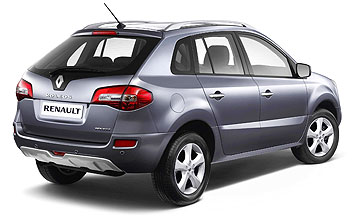BY DAVID HASSALL | 25th Sep 2008

SUVs are not nearly as prevalent in France as other parts of the world – the locals still like their small cars, and driving around the tight confines of Paris and the small towns throughout France will quickly make you realise why – so it clearly the Koleos was produced with foreign markets in mind.
Nevertheless, France is a big country with a lot of open space and long stretches of highway and freeway linking the regional centres, so there is still a need for vehicles capable of lapping-up the kilometres in comfort, not to mention the security of four-wheel drive traction when the long and icy winter sets in.
Of course, the French tend to be set in their ways and do not quickly adapt to trends set in other parts of the world, so it will interesting to see if the useful characteristics of the Koleos win over the hearts and minds of the natives.
Koleos is one of the fruits of Renault’s marriage with Nissan as it is built on the proven platform of the X-Trail, which obviously enabled the French company to quickly make up ground on all the other car-makers that jumped onto the global compact SUV bandwagon much faster.
Collecting the Koleos in Paris and heading straight for the heart of this magnificent city, the first thing we noticed and appreciated was having such a good view over all those little Clios and Smart cars, although the large A-pillar compromised the overall visibility rating.
Reversing into tight parking spaces was naturally a challenge and we only persevered with the automatic wipers until the novelty of their unpredictable nature wore off.
Manoeuvering around town was generally easy due to the light steering and clutch, though the six-speed manual gearshift itself had a touch of the familiar clunkiness that the French traditionally prefer.
Moving out into the country, we appreciated the steering even more because, as appropriately light as it was around town, at higher speeds it proved to be well-weighted and had an excellent on-centre feel, making it feel reassuringly solid on both the motorways and B-roads.
The cruise control buttons are curiously hidden behind the steering wheel and are therefore unfamiliar initially, but the general presentation of the air vents, stalks, various buttons and the audio controls was all good and the instrumentation proved to be simple and clear. What you might call international standard, without the quirkiness you sometimes get in French cars.
Generally speaking, the dash felt solid and the seats proved to be very comfortable and supportive, even over long distances, with good lumbar support for those who need it.
Renault has devised a joystick-like controller for the satellite navigation system – which is strangely not yet offered in Australia, even as an option. The interesting joystick enables you to click through the various functions and set your destinations, and became familiar quite quickly but still had an odd elastic kind of feel.
The main info screen is set high in the dash for good visibility but is unfortunately surrounded by a silver-finish appliqué that may have looked fine in the studio, but in the real world it reflects horribly on the windscreen and is a constant distraction, even when the sun is not catching it. This needs urgent attention by Renault.
Our test vehicle, a 2.0 dCi Dynamique – priced in Australia from $39,990 – was fitted with an optional Bose sound system that sounded superb, and there was an auxiliary plug for an iPod (though nowhere nearby to put it apart from the cupholders, where it flopped around and stretched the limit of our cord).
The strong sound system helped to mask a little wind and road noise, but generally the Koleos was a comfortable and relatively quiet cruiser provided you didn’t prod the diesel engine into the harsh part of its rev band.
The strong and flexible 2.0-litre dCi turbo-diesel has 127kW of power and 360Nm of torque. It comfortably hauled the SUV around with little fuss or noise and was as fuel-efficient as expected. There was no trip computer to accurately check – at least we couldn’t find one and the owner’s manual was in French only – but the official combined figure for Australia is 7.9L/100km.
Of course, the Koleos is no handling champion and, although the soft suspension resulted in a little more lean in the corners than we would like, we really appreciated the good ride quality over mixed surfaces and would happily accept the compromise for this type of vehicle.
It was also brilliant for carrying a variety of luggage, with the split tailgate being especially useful when traveling as you can access smaller items easily and without the need for a large space behind the vehicle. And you can fit heaps of gear under the retractable luggage blind, which is an important security consideration these days.
Overall, the Koleos proved to be a friendly, faithful and solid touring companion, coping with Paris traffic, motorway cruising, mountain passes, winding back roads and tiny villages with efficient aplomb.